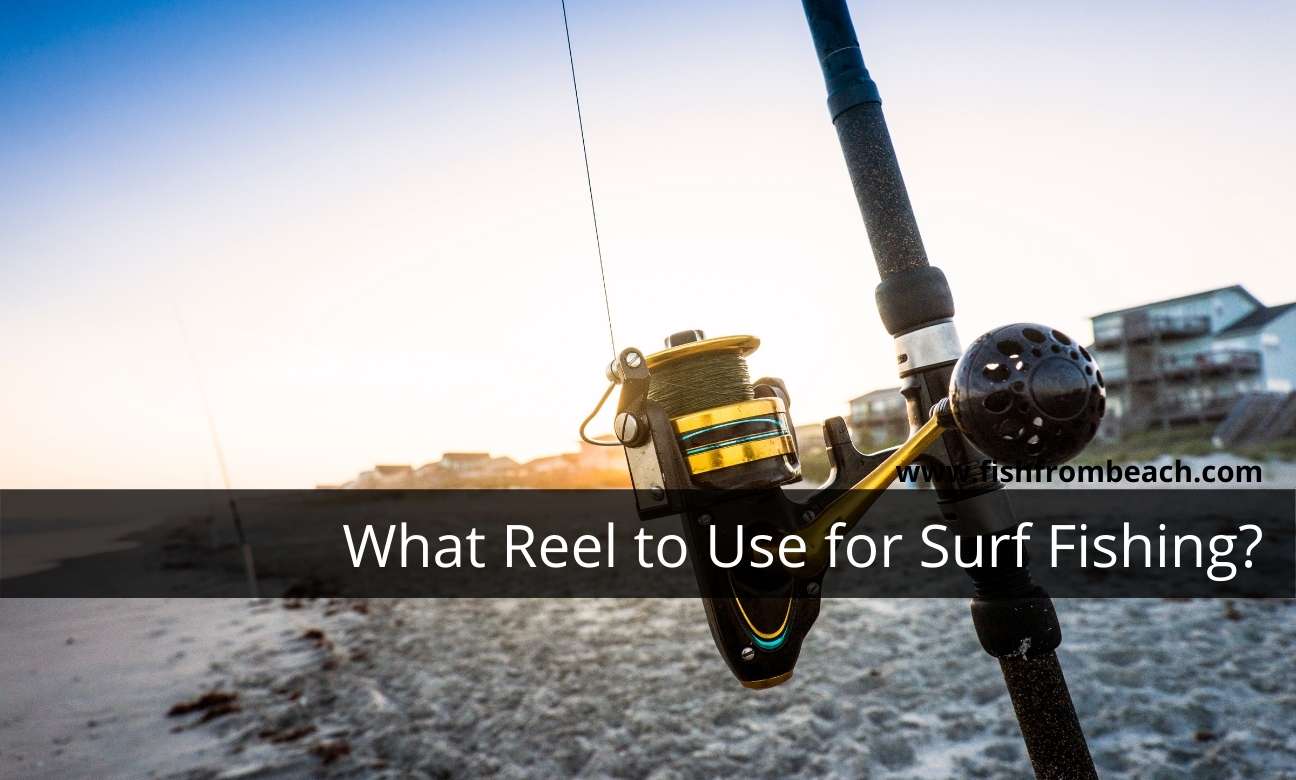When surf fishing, your reel plays a crucial role in everything you do.
Think about it.
When you have to deploy your bait 50-70 meters from shore, everything becomes challenging. You need better casts to reach a good distance, more sensitivity to detect bites, stronger hooksets, more control during fights, and more time and energy to make fish tired and ready to land.
That’s why surf reels are extremely important. With a good purchase, you can make all the above a lot easier and therefore improve your hookup ratio.
We will see in this article how your surf fishing reel can maximize your casting distance, provide you with more sensitivity and control during fights, and how you can attract different/more fish just by switching reels.
We will also discuss how to decide the size of your surf fishing reel for maximum success, and all the other considerations to make for more leverage and control.
So without further ado, let’s dive in.
The takeaway
The buying process of a surf reel can be summarized in 6 steps:
- Choose a reel size that allows you to fit 250-300 yards of your preferred line. Size 4000-6000 is an all-around good range for surf fishing.
- Pick the highest gear ratio you find for that size. Anything higher than 5.3:1 should perform well.
- Make sure the reel is for saltwater fishing.
- Ensure that the reel offers at least 20 pounds of drag
- Check if the reel is designed for saltwater and that it’s watertight.
- Try the reel before you buy it. Make sure everything is working as expected.
Let’s now go more in details and discuss all factors to consider.
Best surf fishing reel size?
Size is the key consideration for surf reels.
In general, when fishing off the beach, you need at least 250-300 yards of line in your reel.
This is what enables you to cast behind the breakers and reach the rewarding spots while keeping enough line on the spool to fight and turn fish.
Now, with the need to be equipped with at least 250 yards of line, 4000-6000 reels prove to be the optimal choice for surf fishing.
Although a smaller reel can work just fine, opting for a reel within the range of 4000-6000 will offer you more flexibility if you plan on upgrading the strength of your line or adding more yards.
On top of that, 4000-6000 reels feel better in hands when paired with typical 10-12 ft surf rods.
Now, should you go for bigger reels? I don’t recommend that.
Too heavy reels induce more fatigue and hurt your balance and sensitivity.
In my view, anything above size 8000 is overkill for surf fishing.
This opinion is endorsed by the answers we received in our survey where we asked 437 fishermen about their favorite surf fishing reel size.
The results revealed that the top choices were the 5000-6000 range (23.57% of votes) and the 4000-5000 range (22.88% of votes).
Other popular choices included the 6000-7000 range (13.27%) and the 3000-4000 range (12.36%).
Reel sizes smaller than 3000 were chosen by around 10% of respondents, while about 15.50% of respondents opted for reel sizes larger than 7000.
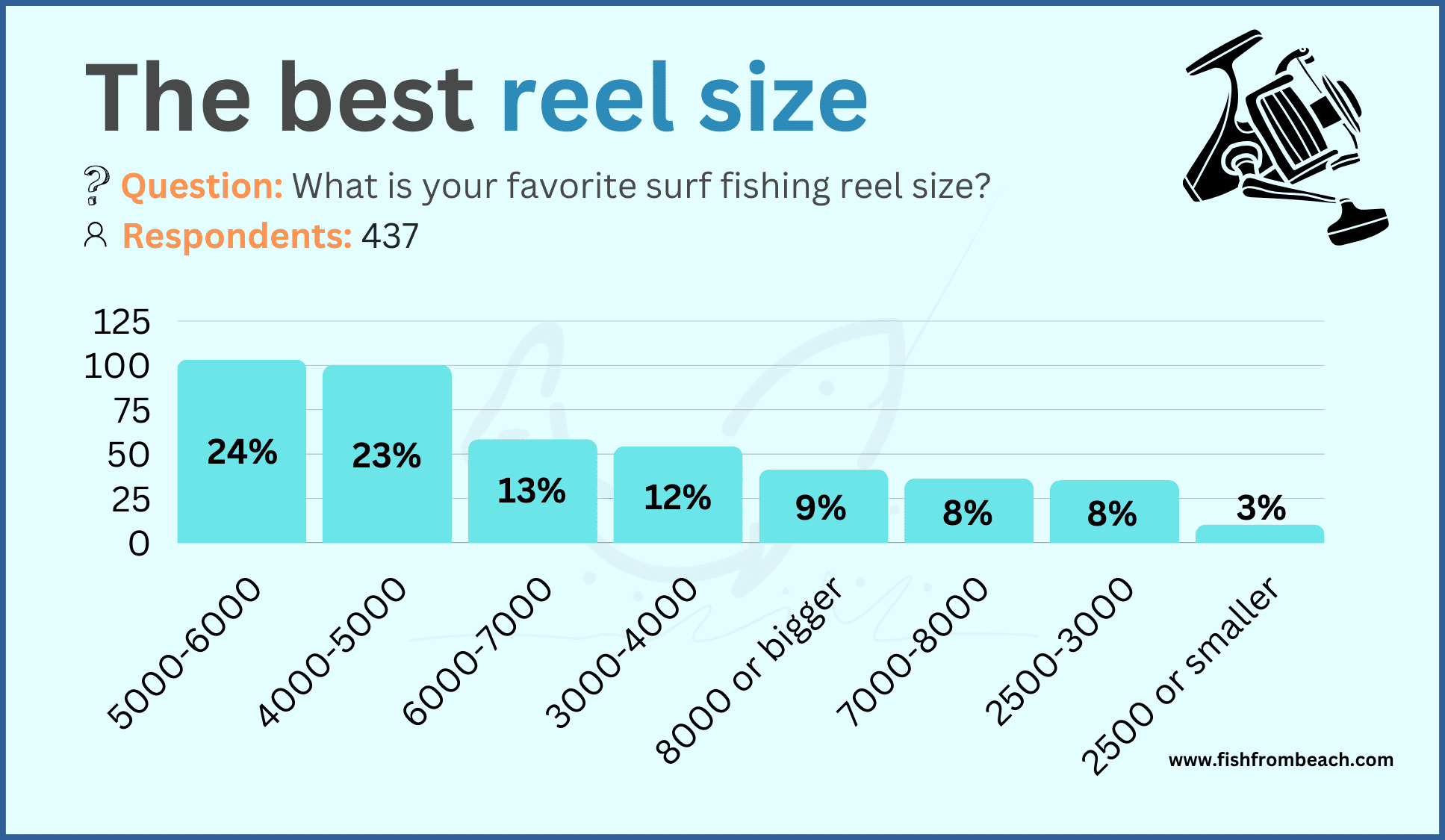
Read more detail about the best reel size for surf fishing.
The gear ratio of surf fishing reels
The size is not the only thing to consider when buying a surf reel. The gear ratio is another variable that can dictate your productivity.
What does the gear ratio mean?
The gear ratio (GR) is the way we measure how fast the reel turns when retrieving the line.
In other words, the gear ratio describes how many 360° turns the spool makes in each turn of the handle.
It’s therefore a good indicator of how fast the reel picks up the line in the retrieve phase.
The rule here is simple, the higher the gear ratio, the more turns the reel makes when retrieving the line, and as a result, the more inches of line it collects.
As a rule of thumb, you should be able to find the gear ratio stated on any modern reel. It’s a simple reading that contains a figure followed by “:1”. Here are some examples.
- 4.5:1
- 6.1:1
- 7.2:1
- 5.7:1
Don’t be intimated by these statements. Here is what they mean:

So the image above says that the reel makes 6.2 turns every time we complete one turn with the handle.
Now when in the tackle store, you will find a wide spectrum of choices that can go from 4:1 up to 12:1. So it can be pretty challenging to decide.
What you need to do here is to only focus on the 4000-6000 size and base all your comparisons on that.
Meaning, do not compare a 9:1 – 2500 freshwater reel with a 5:1 – 7000 surf reel. These are different sizes and cannot be compared.
In general, the bigger the reel, the lower the gear ratio. This is because large reels have large spools and therefore take more effort to rotate.
That said, a low gear ratio doesn’t systematically mean that it collects the line slower. It only does if you are comparing it to a reel of the same size.
In other words, yes, a 4:1 – 4000 reel retrieves the line slower than a 5:1 – 4000 reel. They are the same size and therefore the higher the GR, the faster the retrieve.
However, a 4:1 – 4000 reel may pick up the line faster than a 5:1 – 2500 reel.
It’s a bigger spool and therefore it collects more inches of line even if it takes longer to complete one turn.
I invite you to read the previous paragraph once again. It’s very important to remember that so you can make a better decision when buying a surf reel.
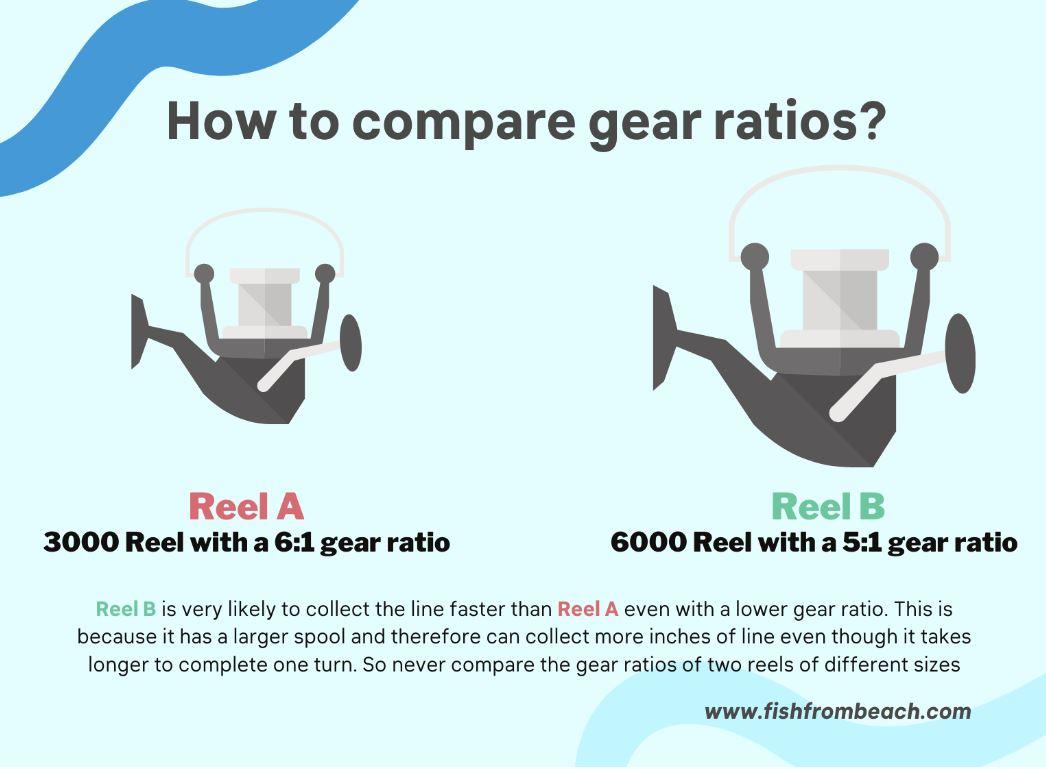
How to choose a good gear ratio for surf fishing?
Anything between 5.3:1 and 5.7:1 should work fine.
A higher GR would be better, but the thing with surf reels is that they are large and therefore do not provide high gear ratios. So it’s generally hard to find surf reels above the 6:1 mark.
Ok, but what if I have many choices? Which number to pick?
As we said, the higher the gear ratio, the faster you pick up the line. So it all returns to what type of fishing you want to do.
In simple words, if you rely on fast line retrieval to catch fish, then you should consider the highest gear ratio you find.
I mean, when using techniques like jigging or spinning, or when relying on the bait/lure animation to draw the attention of fish, a high gear ratio can be useful and may offer you more choices.
Also, species like bluefish, mackerel, and bonito prefer fast-moving prey. They simply don’t like sluggish or wounded food. So a high gear ratio can help with that and allow you to move the bait faster.
On top of that, rocky shores require fast line retrieval to avoid frequent snags.
A high gear ratio is therefore the way to go here because it helps to keep the terminal tackle off the snaggy bottom when collecting the line.
Now on the other hand, if you are fishing open waters and sandy seabeds, or when doing the traditional way of fishing where you simply cast the bait and wait for a fish to take it, then you should be good no matter the GR you pick.
In other words, if the speed at which you collect the line does not dictate your productivity and your catch count, do not spend too much time deciding your gear ratio.
One last thing worth mentioning here is that you can always make a reel pick up the line slower. But you cannot make it go faster than its limit.
That’s why I always recommend going for the highest gear ratio for your preferred reel size. You don’t know when a fast retrieve may become necessary 😉
Spinning reels or conventional reels?
First of all, I invite you to read this article about the differences between conventional and spinning reels in surf fishing.
Now, to answer the question, I would say that it depends on your fishing background and experience.
For example, If you come from a boat fishing background and are used to baitcasters and know exactly how to use them in different situations, then sticking to conventional reels is the best way to go.
Opting for a spinning reel when you master conventionals can be a step backward and counterproductive.
If you know how to use it, stick with it.
Now, If you’re a complete novice looking to start surf fishing and wondering what type of reel to use, I would always recommend a spinning reel.
A beginner with a conventional reel is likely to be a dysfunctional relationship that will end prematurely. This is due to the punishing nature of baitcasters, which may not be ideal for someone who is still learning and looking for a more forgiving option.
As a beginner, the priority is to get your baits in the water and start catching fish as soon as possible. Not spending hours untangling bird nests and adjusting your thumb pressure because your casts either fail or drop too close, right under your feet.
This is why spinning reels are often the recommended choice for beginners. They’re more forgiving of mistakes, allowing you to focus on what you came for: fishing.
This advice also applies to experienced fishermen who are skilled at using spinning reels. Avoid the temptation to switch to baitcasters. While there may be some advantages, the steep learning curve and associated headaches generally make it not worth it.
It’s important to remember that spinning reels are also a great choice for surf fishing, and if you’re not catching enough fish with them, the issue is likely something other than the type of reel you have.
So again, if you know how to use it, stick with it.
In our surf fishing survey, we asked our readers whether they prefer spinning or conventional reels, and among 79 respondents, a substantial majority of 93.67% (74 votes) indicated a preference for spinning reels.
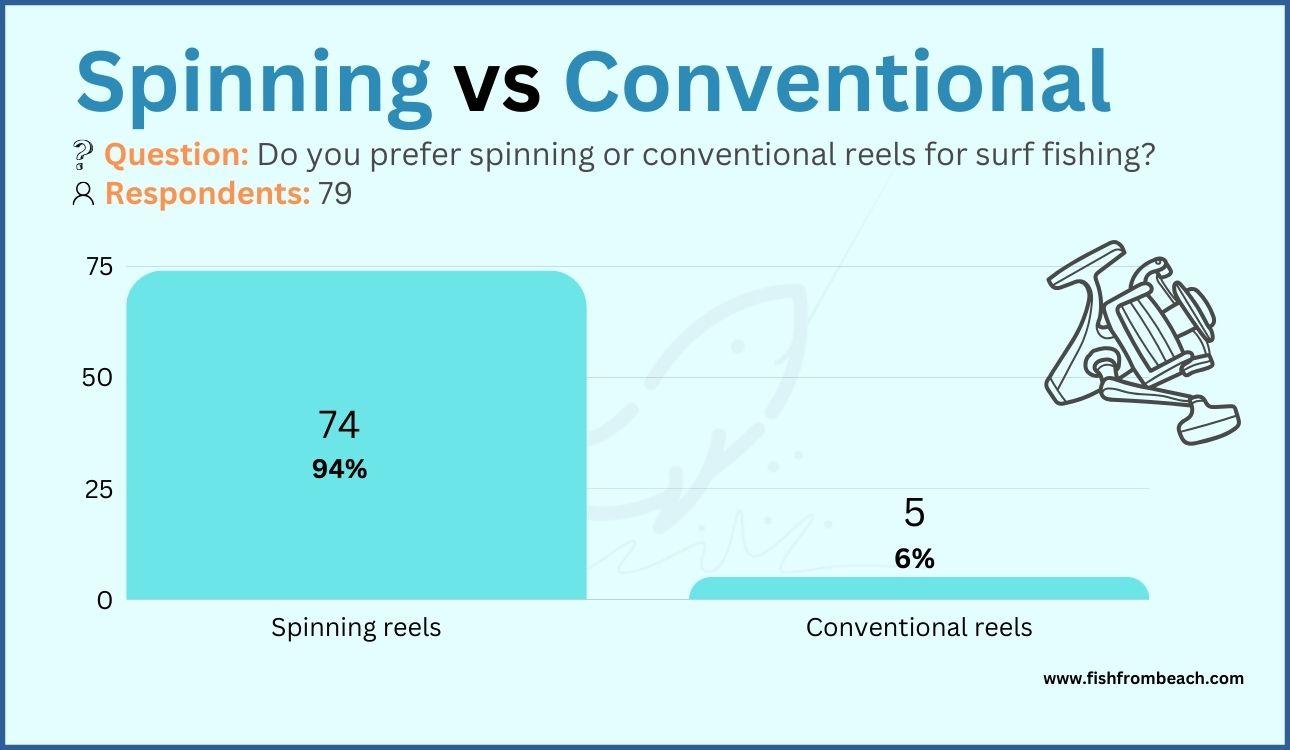
Other considerations on surf reels
Ok, let’s say you found a good reel with an optimal size and gear ratio. What should you do next? Should you go and buy it?
Well, not yet. There are still other things to check.
The first thing is that you need to make sure the reel is designed for saltwater. This sounds obvious but believe me, many anglers use freshwater reels for surf fishing.
You can’t afford that.
Salt speeds up the corrosion process of fishing equipment, and unless your reel is rated for saltwater, it will quickly decay and become no good for use.
Saltwater reels, although not completely immune to salt damage, offer an extra layer of protection and do not corrode easily. With proper maintenance and care, you can make your reel last for years before you notice the first sign of a defect.
With a freshwater reel, however, corrosion happens faster no matter what you do to keep things clean.
Another important thing to check is water tightness.
Salt only accelerates the corrosion process. It does not cause it. What causes rust is water and moisture.
So it’s very important to ensure that the reel is well sealed and doesn’t allow water to get into the inner parts of the reel. Tightness also helps to prevent sand particles, slim, fish guts, dirt, and blood from getting inside the reel.
Personally, I am willing to make small compromises on the reel size and gear ratio to get a good anti-corrosion, water-resistant surf reel.
The maximum drag of the reel is also an important point to check.
You want your reel to provide at least 20 pounds of drag. Although we rarely need all of that when surf fishing, it can sometimes be the last card to play to stop the loss of line in fights against large fish.
Lastly, before buying the reel, ask the seller if you can unbox it and try it. You want to play with the different parts (drag knob, handler, arm bail, etc) and check if everything is as smooth as it’s supposed to be.
Turning the handle is also very important to see if the rotation of the spool is flawless or if there is something off under the cap.
My reel recommendations*
Over the years of my surf fishing experience, I’ve had the opportunity to test various reel brands and types. Some of these reels were classic and old-school, while some had more modern designs and technology.
To be honest, there are many products that I could recommend here, but I’ll narrow it down to just two.
The two reels below are not only affordable, but also popular among surf anglers, reliable, and, most importantly, they do their job perfectly.
1- PENN Battle III Spinning Reel
The PENN Battle III is a universally loved reel for surf fishing. It’s known for its exceptional durability and strong backbone to resist prolonged pressure and abuse and handle heavy fish.
It comes with a maximum drag of 25 pounds and features six bearings. It also has a smooth and satisfying handle rotation.
Moreover, this reel feels great in hands when paired with 10-12 ft surf rods.
2- KastKing Megatron Spinning Reel
On a tight budget, the “KastKing Megatron Spinning Reel” is a great and reliable choice for surf fishing.
What I like the most about this reel is the unmatched line capacity and room in the spool.
For instance, size 6000 provides 300 yards of line capacity for 20 lbs monofilament, which is more than you need for surf fishing.
I’ve used this reel for many trips where I exposed it to a lot of abuse and pressure. What I can confirm is its remarkable durability and resilience, especially considering its price.
Also, I love the sleek and discreet blackish look on it, which I find quite stylish.
Finally, let’s wrap up with the image below, which summarizes everything we said about surf fishing reels.
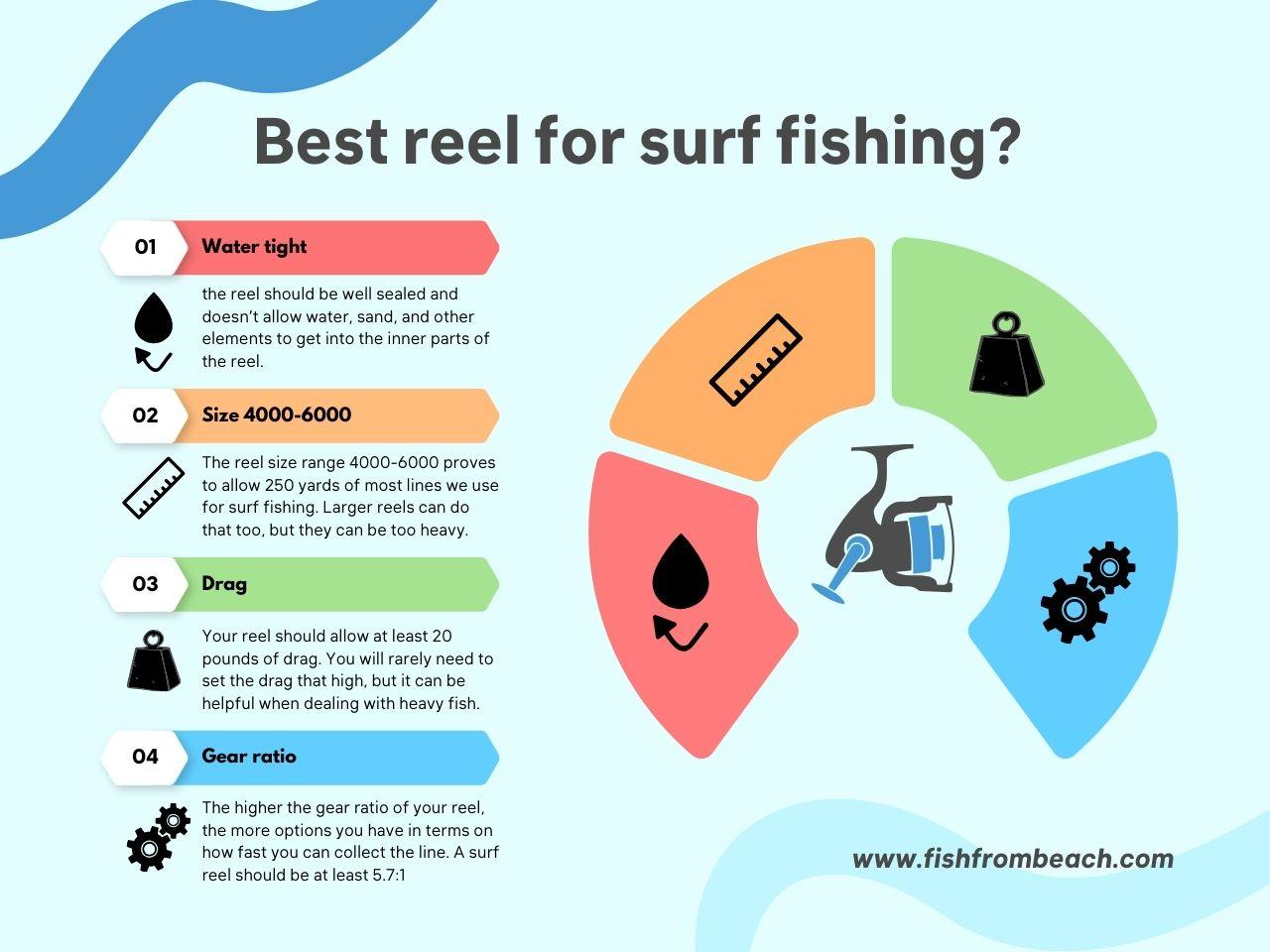
Note (*): If you make a purchase through links from this website, we may get a small share of the sale from Amazon or other similar affiliate programs.
Surf Fishing Survey
Help us provide you with better content by answering simple questions about your surf fishing experience and knowledge.
We will put the collected responses together and turn them into valuable information that will help you catch more fish from shore 😉
Note: No personal information will be collected with your answer.

